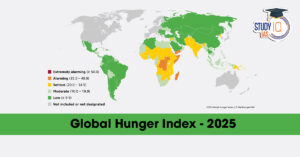Types of Fertilisers
- Urea (Nitrogen-based):
- Urea is the most widely used fertiliser in India, providing nitrogen (N) to plants.
- Nitrogen is essential for vegetative growth, aiding in leaf and stem development.
- India is one of the largest producers and consumers of urea globally.
- Di-Ammonium Phosphate (DAP) (Phosphatic-based):
- DAP contains both nitrogen (18%) and phosphorus (46%), which help in early root development and the overall growth of crops. (Important for wheat and potatoes).
- Phosphatic fertilisers are produced domestically but are heavily reliant on imported raw materials like rock phosphate and phosphoric acid.
- India imports a significant portion of DAP, mainly from countries like Saudi Arabia, Morocco and China.
- Muriate of Potash (MOP) (Potassic-based):
- MOP is used to supply potassium (K) to plants, improving water retention, resistance to diseases and enhancing the quality of crops.
- India is entirely dependent on imports of potash, which is mainly sourced from countries like Canada, Russia, and Belarus.
- Complex Fertilisers (NPK blends):
- These are fertilisers containing a balanced mix of nitrogen (N), phosphorus (P), and potassium (K), such as 12:32:16, 10:26:26, and 20:20:0:13.
- They are used to address the combined nutrient needs of crops.
| PM-PRANAM Scheme |
|


 Light Weight Modular Missile (LMM) — I...
Light Weight Modular Missile (LMM) — I...
 Species Survival Commission (SSC) – IU...
Species Survival Commission (SSC) – IU...
 Global Hunger Index (GHI) 2025: India Ra...
Global Hunger Index (GHI) 2025: India Ra...




















